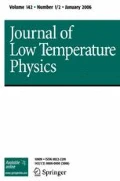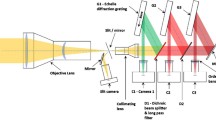Abstract
Advanced ACTPol (AdvACT) is a third-generation polarization upgrade to the Atacama Cosmology Telescope, designed to observe the cosmic microwave background (CMB). AdvACT expands on the 90 and 150 GHz transition edge sensor (TES) bolometer arrays of the ACT Polarimeter (ACTPol), adding both high-frequency (HF, 150/230 GHz) and low-frequency (LF, 27/39 GHz) multichroic arrays. The addition of the high- and low-frequency detectors allows for the characterization of synchrotron and spinning dust emission at the low frequencies and foreground emission from galactic dust and dusty star-forming galaxies at the high frequencies. The increased spectral coverage of AdvACT will enable a wide range of CMB science, such as improving constraints on dark energy, the sum of the neutrino masses, and the existence of primordial gravitational waves. The LF array will be the final AdvACT array, replacing one of the MF arrays for a single season. Prior to the fabrication of the final LF detector array, we designed and characterized prototype TES bolometers. Detector geometries in these prototypes are varied in order to inform and optimize the bolometer designs for the LF array, which requires significantly lower noise levels and saturation powers (as low as \({\sim }\,1\) pW) than the higher-frequency detectors. Here we present results from tests of the first LF prototype TES detectors for AdvACT, including measurements of the saturation power, critical temperature, thermal conductance, and time constants. We also describe the modifications to the time-division SQUID readout architecture compared to the MF and HF arrays.




Similar content being viewed by others
References
R.J. Thornton et al., ApJS 227, 21 (2016). https://doi.org/10.3847/1538-4365/227/2/21
J.W. Fowler et al., Appl. Opt. 46(17), 3444 (2007). https://doi.org/10.1364/AO.46.003444
S.W. Henderson et al., J. Low Temp. Phys. 184(3), 772 (2016). https://doi.org/10.1007/s10909-016-1575-z
S.M. Simon et al., J. Low Temp. Phys. This Special Issue (2018)
D. Li et al., J. Low Temp. Phys. 184(1), 66 (2016). https://doi.org/10.1007/s10909-016-1526-8
S.M. Duff. et al., J. Low Temp. Phys. This Special Issue (2018)
J.P. Filippini et al., in Millimeter, Submillimeter, and Far-Infrared Detectors and Instrumentation for Astronomy V, Volume 7741 of Proceedings of SPIE (2010), p. 77411N. https://doi.org/10.1117/12.857720
K. Irwin, G. Hilton, Transition-Edge Sensors (Springer, Berlin, 2005), pp. 63–150
K.D. Irwin et al., J. Appl. Phys. 83(8), 3978 (1998). https://doi.org/10.1063/1.367153
S.W. Henderson et al., in Millimeter, Submillimeter, and Far-Infrared Detectors and Instrumentation for Astronomy VIII, Volume 9914 of Proceedings of SPIE (2016), pp. 99141G. https://doi.org/10.1117/12.2233895
K. Crowley et al., J. Low Temp. Phys. This Special Issue (2018)
S.K. Choi et al., J. Low Temp. Phys. This Special Issue (2018)
E.S. Battistelli et al., J. Low Temp. Phys. 151, 908 (2008). https://doi.org/10.1007/s10909-008-9772-z
J. Beyer, D. Drung, Supercond. Sci. Technol. 21(10), 105022 (2008). https://doi.org/10.1088/0953-2048/21/10/105022
Acknowledgements
This work was supported by the US National Science Foundation through Award 1440226. The development of multichroic detectors and lenses was supported by NASA Grants NNX13AE56G and NNX14AB58G. The work of KPC, KTC, BJK, and JTW was supported by NASA Space Technology Research Fellowship awards.
Author information
Authors and Affiliations
Corresponding author
Rights and permissions
About this article
Cite this article
Koopman, B.J., Cothard, N.F., Choi, S.K. et al. Advanced ACTPol Low-Frequency Array: Readout and Characterization of Prototype 27 and 39 GHz Transition Edge Sensors. J Low Temp Phys 193, 1103–1111 (2018). https://doi.org/10.1007/s10909-018-1957-5
Received:
Accepted:
Published:
Issue Date:
DOI: https://doi.org/10.1007/s10909-018-1957-5




